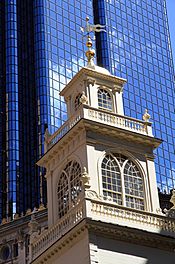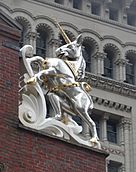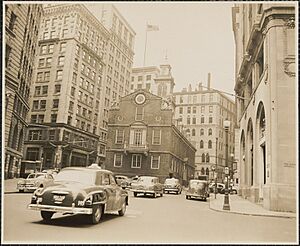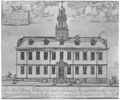Old State House (Boston) facts for kids
|
Old State House
|
|
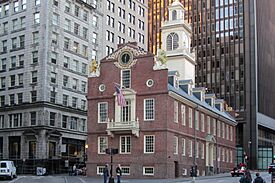
Old State House surrounded by skyscrapers in 2013
|
|
| Location | Boston, Massachusetts |
|---|---|
| Built | 1713 |
| Architect | Original Architect: Thomas Joy (rebuilt 1748) Repairs and alternations: Thomas Dawes (c. 1772) Alterations: Isaiah Rogers (1830) Restoration: George Albert Clough (1881–1882) Renovation: Goody, Clancy and Associates (1991) |
| Architectural style | Georgian |
| NRHP reference No. | 66000779 |
Quick facts for kids Significant dates |
|
| Added to NRHP | October 15, 1966 |
| Designated NHL | October 9, 1960 |
The Old State House is a very old and important building in Boston, Massachusetts. It was built way back in 1713. For many years, it was the main place where the government of Massachusetts met. This building is located where Washington and State Streets meet. It is one of the oldest public buildings still standing in the United States.
The Old State House is a key stop on Boston's famous Freedom Trail. It is the oldest public building left in Boston. Today, it is a history museum. The museum was run by the Bostonian Society until 2019. Then, the Bostonian Society joined with another group to form Revolutionary Spaces. The Old State House was named a National Historic Landmark in 1960. It also became a Boston Landmark in 1994.
Contents
History of the Old State House
Early Days: Government Seat (1713–1776)
Before this brick building, there was a wooden Town House from 1657. That building burned down in a big fire in 1711. The brick Old State House was built between 1712 and 1713. It might have been designed by Robert Twelves.
A cool part of the building is the two large wooden figures on top. They show a lion and a unicorn. These were symbols of the British monarchy. During the American Revolution, the British Royal Coat of Arms was taken down from inside. It was moved to a church in Canada.
The first floor of the building was a Merchant's Exchange. This was a place where business people met. The basement was used for storage. On the second floor, the Royal Governor had his meeting room. Courts for Suffolk County and the highest court in Massachusetts also met here. The middle part of the building was for the Massachusetts General Court. This was special because it had public areas where people could watch their elected officials.
The inside of the building was rebuilt in 1748 after a fire. Luckily, the strong brick walls on the outside were not destroyed.
In 1755, a difficult event happened here. The Lieutenant Governor signed a paper that caused harm to the Penobscot people. In 2021, leaders and children from the Penobscot Nation visited the Old State House. They read the old paper out loud to remember this part of history.
In 1761, a lawyer named James Otis spoke out against unfair British laws. He spoke in the Royal Council Chamber. He lost his case, but his speech made many people think about freedom. John Adams later said that this speech was when "the child independence was born."
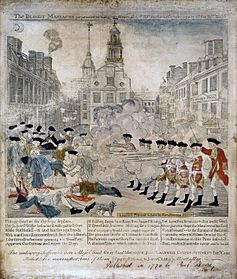
On March 5, 1770, the Boston Massacre happened right outside the building. The Lieutenant Governor, Thomas Hutchinson, stood on the balcony. He told the crowd to go home.
Becoming the Massachusetts State House (1776–1798)
On July 18, 1776, a man named Colonel Thomas Crafts read the Declaration of Independence. He read it from the east side balcony to a happy crowd. Most people in Boston supported independence. The lion and unicorn statues on the roof were taken down. They were burned in a big bonfire on King Street.
After the American Revolution, the Old State House was the main government building for Massachusetts. This lasted until 1798. Then, the government moved to the new Massachusetts State House.
Serving as Boston's City Hall (1830–1841)
From 1830 to 1841, the Old State House became Boston's city hall. In 1830, the inside of the building was changed. A beautiful spiral staircase was added, which is still there today. The building was also damaged by a fire in 1832.
The city hall shared the building with the Boston Post Office. Many private businesses also had offices there. On October 21, 1835, the mayor helped William Lloyd Garrison. Garrison was a newspaper editor who spoke out against slavery. A large crowd was chasing him. He was kept safe in the Old State House for a short time. In 1841, the city hall moved to a different building.
Commercial Use (1841–1881)
After the city hall moved out, the entire building was rented to businesses. Many different types of businesses used the building. These included tailors, clothing stores, and insurance companies. Sometimes, as many as fifty businesses were in the building at once.
The Bostonian Society and the Museum (1881–2019)
In 1881, a group called the Bostonian Society was formed. They wanted to save the Old State House. There were plans to tear it down to build new buildings. In 1881 and 1882, the building was restored. In 1882, new lion and unicorn statues were placed on the east side of the roof. These were copies of the originals that were burned in 1776. On the west side, there is a statue of an eagle. This eagle shows the Old State House's connection to American history.
Since 1904, part of the building's basement has been a subway station. It is called the State Street MBTA station. The Blue Line subway opened in 1904, and the Orange Line opened in 1908.
Queen Elizabeth II visited the Old State House on July 11, 1976. She was there with her husband to celebrate 200 years of the United States. She stood on the famous balcony and gave a speech to a large crowd.
If Paul Revere, Samuel Adams, and other patriots could have known that one day a British monarch would stand on the balcony of the Old State House, from which the Declaration of Independence was first read to the people of Boston, and be greeted in such kind and generous words—well, I think they would have been extremely surprised! But perhaps they would also have been pleased to know that eventually we came together again as free peoples and friends to defend together the very ideals for which the American Revolution was fought.
The Old State House Today
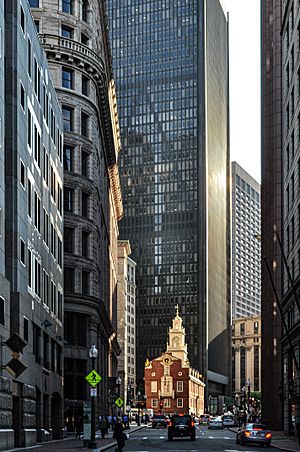
Today, very tall buildings surround the Old State House. These are part of Boston's financial district. Even with these tall buildings, you can still see the Old State House clearly. It sits above the State station for Boston's subway. You can enter the station from the building's basement.
The Old State House museum is open almost every day of the year. It is a popular stop on the Freedom Trail. Right in front of the museum, you can see the spot where the Boston Massacre happened. This spot is marked by a circle of cobblestones. The museum offers many programs and exhibits, some about the Boston Massacre.
Keeping the Building Safe
The Old State House often has projects to keep it in good condition. In 2006, the museum was repaired because water had damaged its stone walls. This damage got worse during a hurricane in 2005. This repair project was even shown on a TV show called Save Our History.
In 2008, the building's tower was greatly restored. The weathervane from 1713 was re-covered in gold. The windows were fixed, and the roof was replaced. This work helps protect the building and the old items inside. It also protects the 1831 clock by Simon Willard.
Replicas of the Old State House
You can find copies of the Old State House in a few other places:
- Brockton Fairgrounds, Brockton, MA
- Curry College, Milton, MA
- Eastern States Exposition ("The Big E"), West Springfield, MA
- Weymouth Civic District, Weymouth, MA (town hall)
Images for kids
See also
 In Spanish: Vieja Casa de Estado (Boston) para niños
In Spanish: Vieja Casa de Estado (Boston) para niños




